Creating a new document in Banktivity
To get started using Banktivity, the first thing you will need to do is create a document. Choose File > New > Document to start the new document assistant:
If you have used Banktivity on this device before, you will see an option to either open an existing document or to Create a new document.
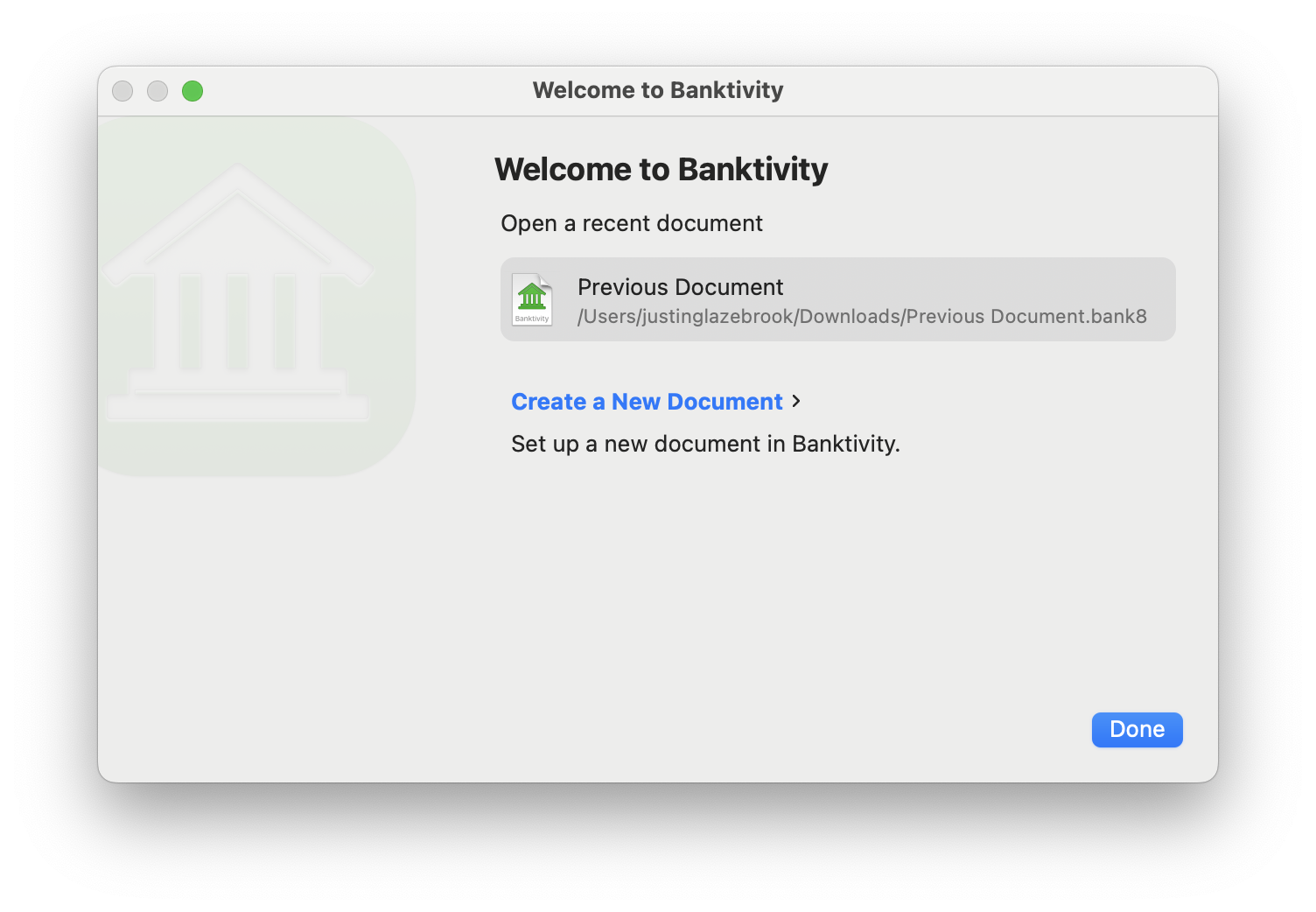
Have you used Banktivity previously or are you a new user?
Banktivity requires customers to have a user ID in order to access the free trial and subsequent subscription services that we offer. You may have an existing ID from a previous use of the software or you may need to create yourself a new one now. If you have an existing Banktivity ID please choose "I've Used Banktivity Before", If you do not have an existing ID you would choose "I'm New"
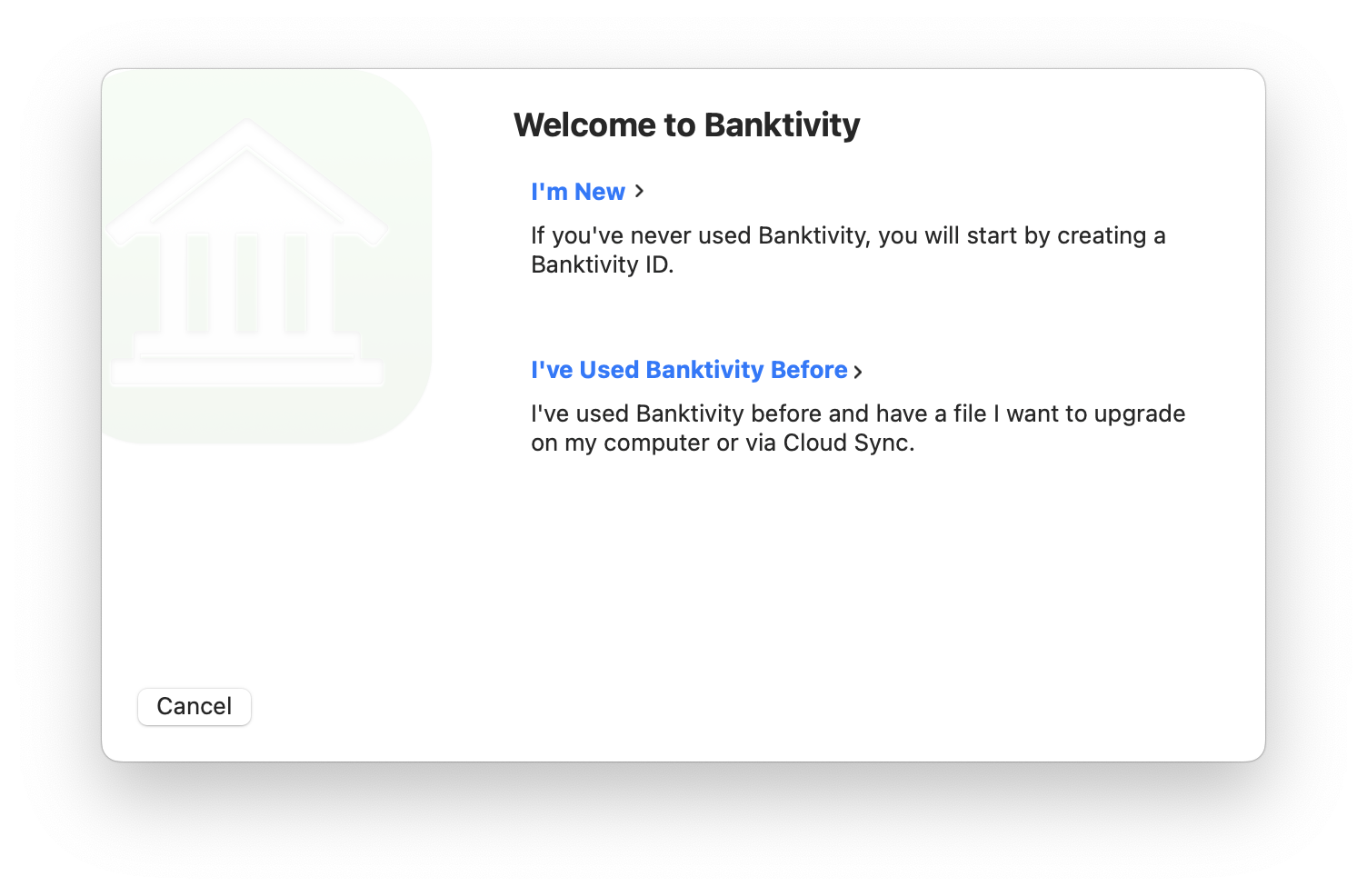
How would you like to create the new document?
You will need to choose how you would like to create this new document. Read on to find out more about what each option entails.
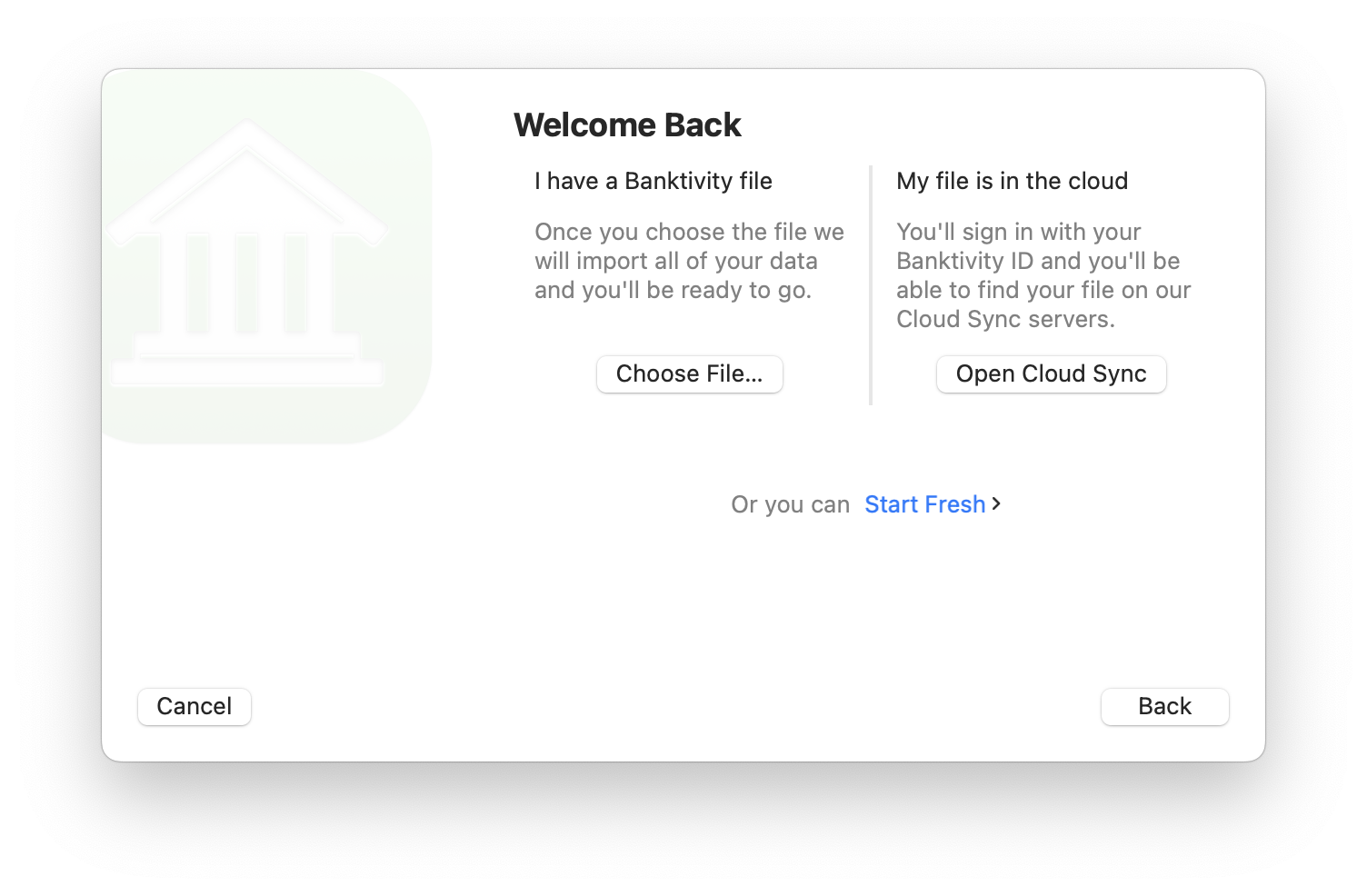
If you want to create a new document from Quicken, a QIF file, Cloud Sync, or an older version of Banktivity, you can choose the appropriate menu item under File > New to jump right to the next step for that option.
Start Fresh
Choose this option to create a new Banktivity document. If you had chosen that you have previously used Banktivity in the previous step, the assistant will now ask you to log in to your existing Banktivity ID. However, if you chose to create a new ID you will not need to sign in again during the document creation.
The next step is to decide which set of default categories you would like Banktivity to add to your document. Banktivity includes two predefined sets of categories: "Home" is intended for personal use, "Business" for professional use. Both sets include categories that are assigned standard US tax codes. Click whichever option you prefer.

Banktivity will next ask you some questions about what types of accounts you plan to track and whether you plan to track multiple currencies in this document. This is going to help the software to give you a recommended subscription tier to sign up for with your Banktivity ID. This can be changed later but it is typically best to choose what is recommended after making those choices.
Next, Banktivity will prompt you to add accounts to the document: please see About Accounts for more information.
Once you finish adding accounts, Banktivity will ask whether you want it to create some helpful reports automatically. If you check the box and click "Continue," reports will be added to the sidebar based on the types of accounts you added to the document.
The final step you will need to complete is that you will be prompted to choose a location in which to save your document: enter a name for the document in the sheet that appears, choose a location, and click "Save."
Banktivity will present you with a "Congratulations" screen to inform you that your new document is ready to use. Click "Done" to continue to the main window.
Open Cloud Sync Document
If you previously uploaded a Banktivity document to the Cloud Sync server and want to connect to it, click this option. First you will see a warning prompt to inform you that upgrading from Banktivity 5, 6, 7 and 8 should not be done via Cloud Sync, as some features (such as reports, account groups, file attachments, and category images) do not sync and will not be available in your new document. If you intend to upgrade from Banktivity 5, 6, 7, or 8 click "Upgrade Document" and skip to the section below titled "Choose File..."
Otherwise, click "Continue With Cloud Sync." You will be prompted to log in with your Banktivity ID, then the next screen will ask you to choose the cloud document you wish to open:
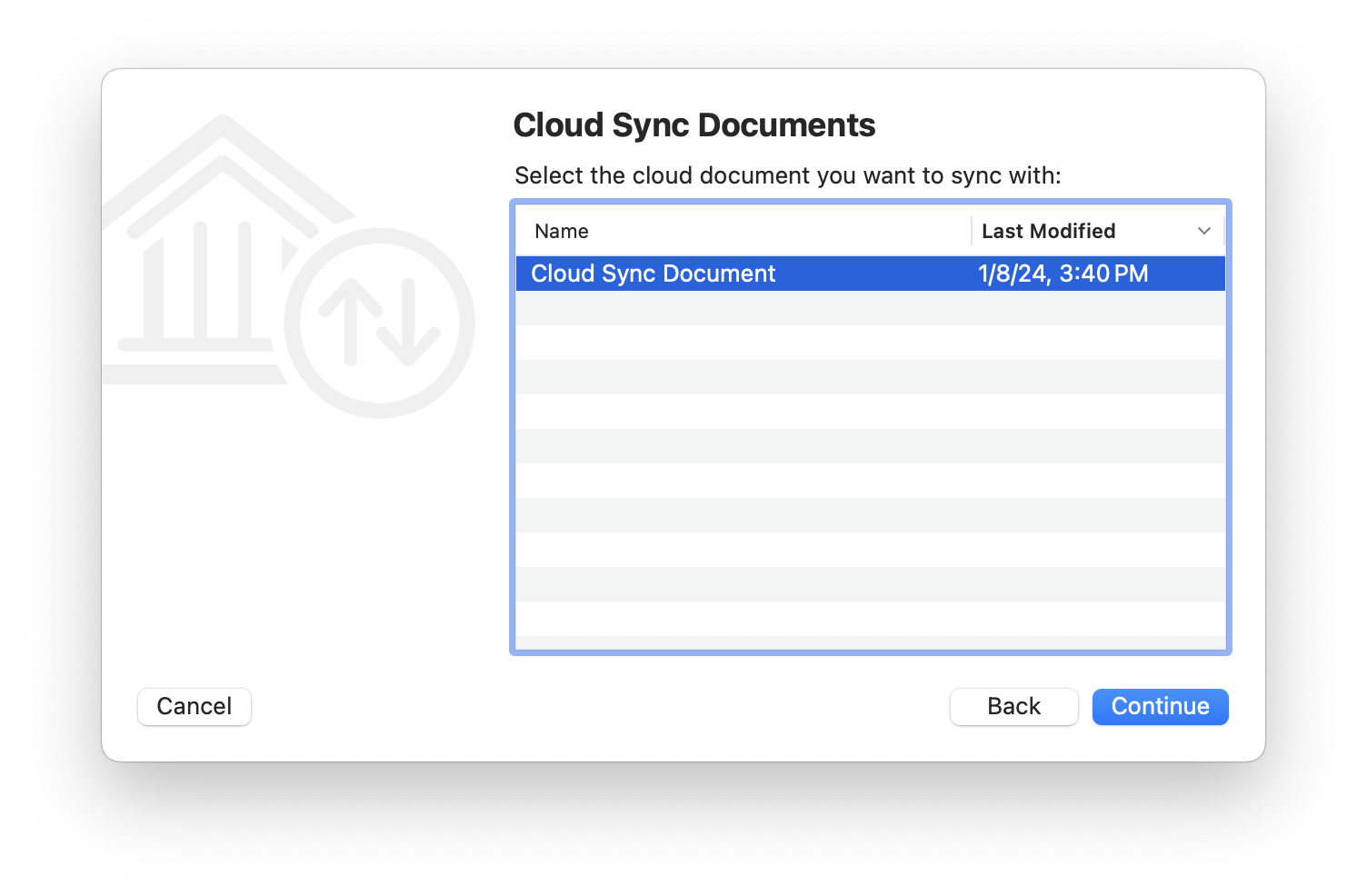
Select a document in the list and click "Continue," then Banktivity will prompt you to enter the password required to access the document. Enter the correct password and click "Continue." Banktivity will then begin downloading your data from the Cloud Sync server.
Once the download process has finished, click "Done" to proceed. Banktivity will then ask you to choose a location in which to save your document: enter a name for the document in the sheet that appears, choose a location, and click "Save."
Finally, Banktivity will present you with a "Congratulations" screen to inform you that your new document is ready to use. Click "Done" to continue to the main window.
Choose File...
To upgrade from a previous version of Banktivity, or to import data from another financial management program, click this option. The next screen will ask which software you want to import from. This will open a window where you will be able to select the file to import. At this time we support importing data from iBank 5, Banktivity 6, Banktivity 7 and the following formats from other financial applications; OFX (MS Money), QIF (Quicken), QFX (Quicken Web Connect), or CSV
Upgrading Older Banktivity Documents
If you previously used Banktivity and you want to upgrade your data for use with the new Banktivity, select "Choose File," select the document you want to upgrade, and the process will begin immediately. Once the upgrade process has finished, Banktivity will show you the results. If any changes were made to your data during the upgrade process, a window will appear to show you the details. See Upgrade Messages for more information about this window. Click "Save Results" if you want save a copy of the changes so you can review them later.
When you are finished with the upgrade results, click "Continue" to proceed. Next, Banktivity will ask if you want to import passwords for your online accounts. If you previously used Direct Access or OFX direct download to update your accounts, Banktivity will need your permission to access the Keychain to read those passwords. If you click "Import Passwords," you will then see a prompt for each account password you have saved: click "Always Allow" repeatedly to grant Banktivity permission to use each one.
If you choose to click "Skip" instead, your accounts will import but they will not be able to download updates automatically. At a later time, you will need to manually enter the passwords for your online accounts to reconnect them.
Next, Banktivity will highlight some features that are new in Banktivity. Click "Get Started," and you will be asked to save the new document. Enter a name for the document in the sheet that appears, choose a save location, and click "Save." Your original document will not be modified, in case you ever want to open it using an old version of Banktivity.
Finally, Banktivity will present you with a "Congratulations" screen to inform you that your new document is ready to use. Click "Done" to continue to the main window.
Quicken for Mac 2015 or later and Quicken Essentials:
- Launch Quicken.
- Review your category names. If any names are longer than 55 characters, please abbreviate them (they can be restored in Banktivity after the import is complete). Please note that subcategory names, when exported, will include the names of their parent categories in the following manner: Category:Subcategory1:Subcategory2. This entire set of names must be 55 characters or less (including the colons) in order to avoid being truncated during the export process.
- Choose File > Export > Quicken 2007 Transfer File and save the QMTF file on your Desktop.
- In Banktivity, click "Choose File" and select the QMTF file.
You may notice that some of your account names are truncated. Quicken limits account names to 31 characters when it exports them, but you can rename the accounts during the Banktivity import process.
Quicken for Mac 2007 or earlier:
- Launch Quicken.
- Choose File > Export > To QIF and save the QIF file on your Desktop.
- In Banktivity, click "Choose File" and select the QIF file.
Quicken for Windows:
- On your PC, launch Quicken.
- Open any closed accounts.
- Export your data to a QIF file. Since the export command may vary between different versions of Quicken, consult the documentation for help with locating and using this command. All of your Quicken data should be saved to a single file if possible, but the importer will accept multiple files if necessary. If you have a choice of "Strict" vs. "Loose" QIF formats, use "Loose." Do not choose any options labeled "for Mac."
- Copy the QIF file or files to your Mac's Desktop using a flash drive, network transfer, email attachment, or other means of PC-to-Mac file transfer.
- In Banktivity, click "Choose File" and select the QIF file. If you have multiple QIF files, Shift-click to select them all at once.
Microsoft Money:
- On your PC, launch Money.
- Open any closed accounts.
- Export each account to a QIF file. Since the export command may vary between different versions of Money, consult the documentation for help with locating and using this command. If you have a choice of "loose" or "strict" formats, choose "loose." Make sure to name each QIF file after the account it came from - if the account names do not match exactly, errors may result in the imported data (particularly with transfers between accounts).
- Copy the QIF files to your Mac's Desktop using a flash drive, network transfer, email attachment, or other means of PC-to-Mac file transfer.
- In Banktivity, click "Choose File" and Shift-click to select all the QIF files at once.
Other software:
- Launch your other financial program.
- Open any closed or hidden accounts (if your software lets you close or hide accounts).
- Export your data to a QIF file. Since the export command may vary from one financial manager to the next, consult the documentation for help with locating and using this command. All of your financial data should be saved to a single file if possible, but the importer will accept multiple files if necessary.
- If your financial program does not run on a Mac, copy the QIF file or files to your Mac's Desktop using a flash drive, network transfer, email attachment, or other means of PC-to-Mac file transfer.
- In Banktivity, click "Choose File" and select the QIF file. If you have multiple QIF files, Shift-click to select them all at once.
Complete the import
Once you have chosen the file(s) to import, Banktivity will display a list of all the accounts available for importing:
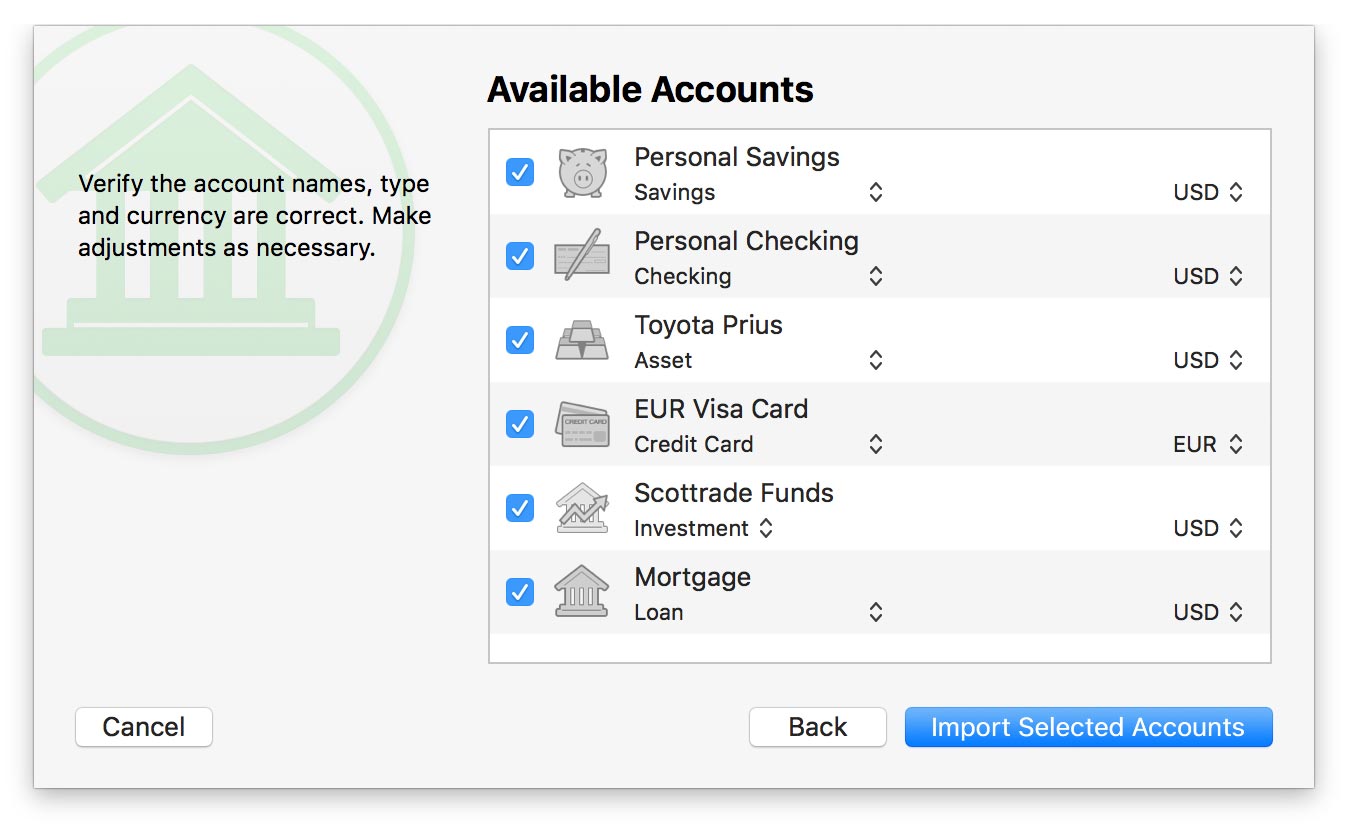
Check off the accounts you wish to use in Banktivity. You can rename an account by clicking on its name, change the account type by clicking on the default type and choosing an alternative from the drop-down menu, or change the currency by clicking it and choosing another. Once you have all the accounts set up the way you want them, click "Import Selected Accounts." If Banktivity cannot recognize the dates in the file, you will be asked to choose a date format before proceeding.
When importing multiple QIF files, Banktivity will process one file at a time. You will be asked to configure accounts for each file in succession, rather than selecting them all in the same window.
Once the import process has finished, click "Continue" and Banktivity will prompt you to choose a location in which to save your document: enter a name for the document in the sheet that appears, choose a location, and click "Save." Banktivity will then present you with a "Congratulations" screen to inform you that your new document is ready to use. Click "Done" to continue to the main window.